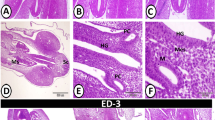Abstract
The changes in the cytoplasmic components of the, cells of the alimentary tract during fasting and after feeding have been described for several animals of widely separated groups, but, so far as I am aware, there are only three papers on the cytology of the digestive glands of the domestic fowl1,2,3, and knowledge is still scanty regarding the behaviour of the cytoplasmic inclusions of these structures. The present observations were carried out on fixed material obtained from young chickens, and yielded information which does not seem to have been previously recorded. Samples from different parts of the intestinal tract and from the associated glands were, taken from birds killed after a twenty-four hours fast and at periods ranging from half an hour to six hours, after a meal.
This is a preview of subscription content, access via your institution
Access options
Subscribe to this journal
Receive 51 print issues and online access
$199.00 per year
only $3.90 per issue
Buy this article
- Purchase on Springer Link
- Instant access to full article PDF
Prices may be subject to local taxes which are calculated during checkout
Similar content being viewed by others
References
Argeseanu, S., and May, R. M., Arch. Anat. Micr., 34 (1938).
Dalton, A. J., Anat. Rec., 58 (1933).
Hibbard, A., J. Morph., 70 (1942).
Pollister, A., Phys. Z., 14 (1941).
Author information
Authors and Affiliations
Rights and permissions
About this article
Cite this article
CHODNIK, K. Cytology of Alimentary Tract and Associated Glands of the Fowl, Gallus domesticus. Nature 160, 62–63 (1947). https://doi.org/10.1038/160062a0
Issue Date:
DOI: https://doi.org/10.1038/160062a0
Comments
By submitting a comment you agree to abide by our Terms and Community Guidelines. If you find something abusive or that does not comply with our terms or guidelines please flag it as inappropriate.



